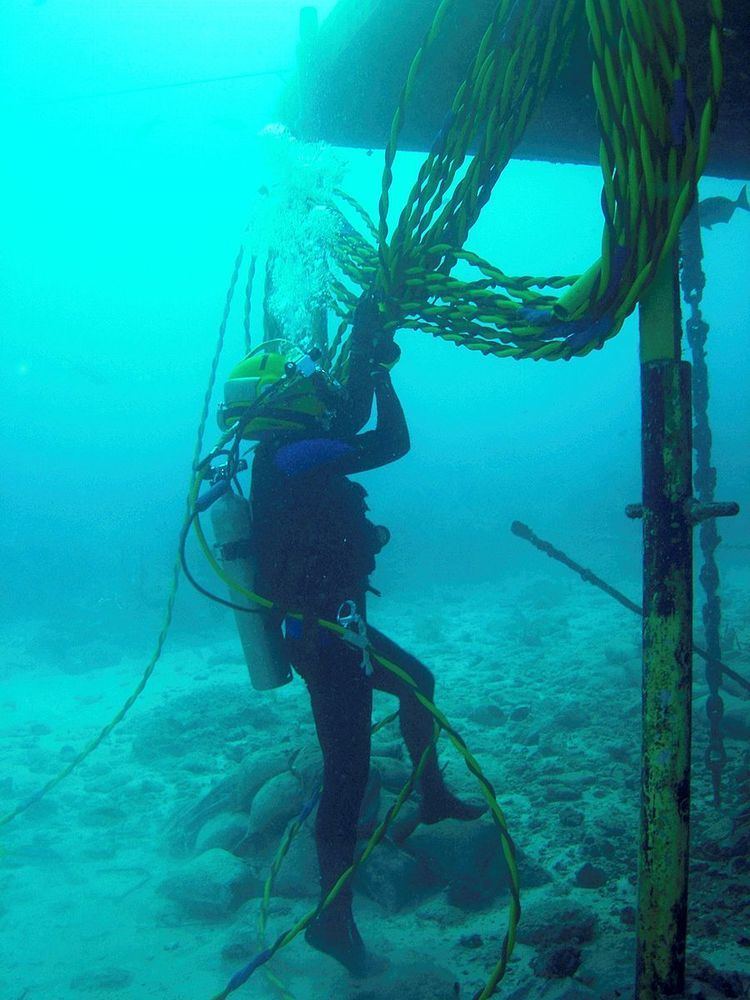 | ||
An aquanaut is any person who remains underwater, breathing at the ambient pressure for long enough for the concentration of the inert components of the breathing gas dissolved in the body tissues to reach equilibrium, in a state known as saturation. Usually this is done in an underwater habitat on the seafloor for a period equal to or greater than 24 continuous hours without returning to the surface. The term is often restricted to scientists and academics, though there were a group of military aquanauts during the SEALAB program. Commercial Divers in similar circumstances are referred to as Saturation Divers. An aquanaut is distinct from a submariner, in that a submariner is confined to a moving underwater vehicle such as a submarine that holds the water pressure out. Aquanaut derives from the Latin word aqua ("water") plus the Greek nautes ("sailor"), by analogy to the similar construction "astronaut".
The first human aquanaut was Robert Sténuit, who lived on board a tiny one-man cylinder at 200 feet (61 m) for 24 hours in September 1962 off Villefranche-sur-Mer on the French Riviera. Military aquanauts include Robert Sheats, author Robin Cook, and astronauts Scott Carpenter and Alan Shepard. Civilian aquanaut Berry L. Cannon died of carbon dioxide poisoning during the U.S. Navy's SEALAB III project. Scientific aquanauts include Richard Cooper, Stephen Neudecker, Al Waterfield, Jonathan Helfgott, Robert Dill, Sylvia Earle, Ian Koblick, Neil Monney, Chris Olstad, Joseph B. MacInnis, John Perry, Harold "Wes" Pratt (on whom the character Matt "Winch" Hooper in Jaws was based), Phillip Sharkey, Dick Rutkowski, Alina Szmant, Bill High, Phil Nuytten, Matthew Morgan, Steven Miller, Morgan Wells, C. Lavett Smith and about 700 others, including the crew members (many of them astronauts) of NASA's NEEMO missions at the Aquarius underwater laboratory.
Accidental aquanaut
A Nigerian ship's cook, Harrison Odjegba Okene, survived for 60 hours in a sunken tugboat, Jascon-4, that capsized on 26 May 2013 in heavy seas while it was stabilising an oil tanker at a Chevron platform in the Gulf of Guinea in the Atlantic Ocean, about 32 km (20 mi) off the Nigerian coast.
Eleven crew members died, but Okene survived almost three days by finding a large air pocket with sustainable air. On the third day he was discovered by South African divers employed by a DCN global diving company to investigate the scene and recover the bodies.
The rescuing divers transferred Okene into a closed diving bell and return to the surface for decompression from saturation. Okene fell into unconsciousness during the transfer even though he was wearing an underwater breathing helmet.
The boat came to a rest upside down on the sea bottom, luckily only to a depth of 30 m (98 ft). In total darkness, Okene felt his way into the engineer's office 1.2 m (3 ft 11 in) in height that contained air sufficient to keep him alive. Additionally, he fabricated a platform from a mattress and other materials which kept the upper part of his body above water that helped reduce heat loss.
